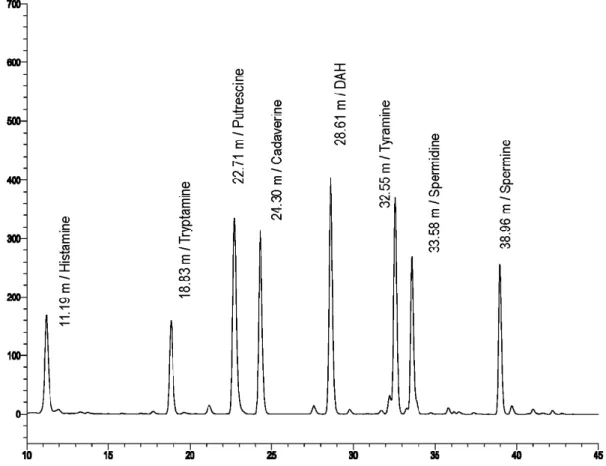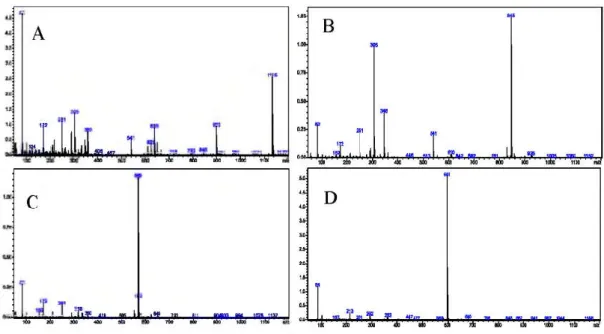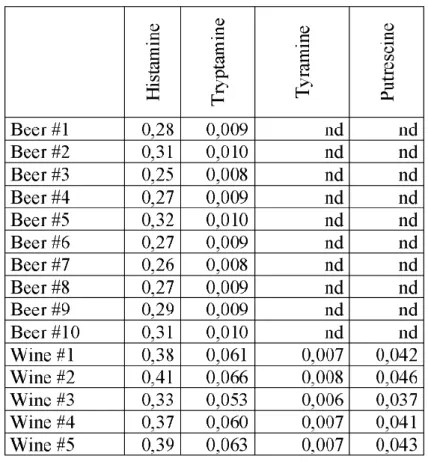PÉTER FORGÓ*, ATTILA KISS
DEVELOPMENT AND ADAPTATION OF NOVEL HPLC PROCEDURE TO CHARACTERIZE BIOGENIC AMINES IN
FOOD SAMPLES
Abstract: A high performance chromatographic (HPLC) method for the si- multaneous determination of seven biogenic amines (histamine (HI), tryptamine (TR), tyramine (TY), putrescine (PUT), cadaverine (CAD), spermidine (SPD) and spermine (SPM)) in food products has been developed. The technique was applied to determine the biogenic amine content of wine and bear samples, which were treated with dansyl-chloride to form dansyl derivatives of biogenic amines. A gradient elution program was applied in the separation process in- volving water (A) and acetonitrile (B) solvents. Quantitative detection of the compounds was carried out with light absorbance at 336 nm, the components were identified with a mass-spectrometer detector by their molecular mass. The sensitivity of the applied method was 3-5pM for the studied derivatives. The method was tested on commercially available beer and wine samples, where histamine was proven to have the highest level (0.25-0.32 mM in beers, while wines showed higher histamine level 0.33-0.41mM). Beers contained detectable amount of tryptamine (around 0.01 mM), while wines had notable tyramine and tryptamine content.
Keywords: food products, biogenic amine, HPLC-MS, derivatization, diode- array detection.
Introduction
Biogenic amines (BAs) represent a unique class of natural compounds and can be characterized as small or medium sized organic amine based derivatives with aliphatic, aromatic and heterocyclic moieties.1 Biogenic amines are pro- duced in biochemical metabolism during fermentation or brewing food produc- tion processes2 by microbial degradation2, 3 and decarboxylation process from amino acids associated with food spoilage. Moreover, biogenic amines can be formed “in vivo” from the corresponding aldehydes4. The members of this mo- lecular class can be found in a wide range of food products including fish, meat, vegetables, fruits, nuts, dairy products, brewed drinks and fermented food prod- ucts. However, the total biogenic amine content is strongly correlated to the
microorganisms present in the sample. Several studies have pointed out their high biological activity that can increase hypertension as tryptamine5, can affect cardiovascular, muscle, neural, gastric functions6, 7 and can cause food poisoning as histamine. Furthermore, the members of the family have a potential to form carcinogen nitrosamines with nitrite.8 Nevertheless, the putrescine based polya- mines play an important role in cellular growth and metabolism.9
As a result of the high biological relevance, several analytical methods have been developed for the qualitative and quantitative detection of biogenic amines.
Fluorescence based protocols have been developed for the detection of histamine in fish10, ", cheese and other fermented food products12. Thin layer chromato- graphic methods have been applied to determine natural13 and derivatized com- pounds14 involving densitometric detection13. Gas-chromatographic and HPLC15 methods coupled with diode array and mass spectroscopic detection16 have been utilized to study the biogenic amine content in brewed17 and other food prod- ucts18, 19, 20. Capillary electrophoretic21, 15 separation and pulsed amperometric22 detection methods have also been used to determine biogenic amine contents in several food products. Electrochemical biosensors23 have also been widely used in the detection of biogenic amines.24, 25
Our purpose was to develop an efficient HPLC-MS method in order to detect biogenic amines in food products and brewed drinks. The method was optimized for the detection and quantitative analysis of seven biogenic amines: histamine (HI)(1), tryptamine (TR)(2), tyramine (TY)(3), putrescine (PUT)(4), cadaverine (CAD)(5), spermidine (SPD)(6) and spermine (SPM)(7), the experiments were run with the presence of diamino-heptane (DAH)(8) as internal standard.
f f '
H
\ih2
C t f ' ~
H
/?—\ /^NH2
h o—
f
y — /Histamine (HIS) (1) Tryptamine (TR) (2) Tyramine (TY) (3)
k ^ N H 2 k ^ N H 2
C m'f
Putrescine (PUT) (4) Cadaverine (CAD) (5) Spennidine (SPD) (6)
r|1H2
r - A
N H 2
0 ^ 0
Spermine (SPM) (7) Diamino-heptane (DAH) (8) Dansyl-chloride (9) Figure 1. The structure o f the investigated compounds.
Experimental procedure
Approximately 9 mg of the standard seven biogenic amines and diamino- heptane (DAH) were dissolved in a 25 ml volumetric flask. A standard dansyl- chloride(9) solution was also prepared in acetone solution (23.6 mg dansyl- chloride in 1.18 ml acetone). Standard solutions (250, 200, 150, 100 and 50 pl from the stock solution were used to dilute the solution to 0.85 ml) were pre- pared by the dilution of the stock solution and adding sodium-hydroxide and dansyl-chloride. The standard solutions were kept in 60°C for one hour, then the excess dasyl-chloride was decomposed by the addition of ammonia (50 pl). Af- ter filtration and addition of acetonitrile (0.5 ml) 10pl of the standard solution was injected for HPLC analysis. Real samples were treated the same way as standard solutions, 250 pl of wine and beer samples were used for the HPLC analysis with the addition of sodium-hydroxide and dansyl-chloride stock solu- tions. The derivative producing reaction took place during one hour at 60°C and the excess dasyl-chloride was decomposed by the addition of ammonia (50 pl).
After filtration and addition of acetonitrile (0.5 ml) 10pl of the sample solution was injected for HPLC analysis. A Shimadzu LCMS-2010 HPLC instrument was used for the separation, which was coupled to a mass detector with atmos- pheric pressure chemical ionization (APCI) in the m/z range of 100-1200 amu with positive ion detection mode and 1.5 kV detector voltage. The diode-array detector was used for quantitative analysis and it covered a 190-800 nm wave- length range, the biogenic amine content was analyzed at 336 nm. The chroma- tographic column was a YMC-Pack ODS-AQ 250x4.6 mm, 5pm. A gradient elution was carried out with acetonitrile (B) and water(A) solvents at a flow rate of 0.4 ml/min and with the following gradient profile: 0 min (65% B), 2 min (65% B), 20 min (80 % B), 24 min (90 % B), 32 min (100 % B), 40 min (100 % B), 42 min (90 % B), 44 min (80 % B), 47 min (65 % B).
Results and discussion
Specific chromatographic conditions have been elaborated and adjusted throughout our experiments. Variable parameters have been tested such as elu- ents and flow rates. Acetonitrile-water solvent system with gradient elution proved to be the most efficient, while 0.4 ml/min was found to be most appro- priate flow rate.
The seven biogenic amine derivatives and the reference diamino-heptane ap- peared separately in the chromatogram with the following retention times: HIS:
11.19 min, TR: 18.83 min, PUT: 22.71 min, CAD: 24.30 min, DAH: 28.61 min, TY: 32.55 min, SPD: 33.58 min, SPM: 38.96 min. (Figure 2). The signals in the chromatograms were assigned by their mass spectrum extracted from the total
function of the injected amount of eight derivatives showed linear characteristics in the 5X10"10-5X10"9 mole concentration region (figure 4). The calculated sensi- tivity using the calibration curves fall to the 3-5pM concentration region. These experimental conditions were used to determine the biogenic amine content of commercially available ten beer and five wine samples The main biogenic amine component was histamine (HIS), the detected level varied between 0.25 mM and 0.31 mM. The tryptamine content was around 0.01 mM in the ten beer samples, tyramine, putrescine, cadaverine, spermine and spermidine could not be deter- mined quantitatively in beer samples. The histamine content of the five wine samples were a little higher than in beers, the values varied between 0.33 mM and 0,41 mM. Tryptamine content was proven to be between 0.05mM and 0.06mM, while the thyramine concentration was even more lower (0.006-0.008 mM). Putrescine contrentrations in wine samples were between 0.03 mM and 0.04 mM. Cadaverine, spermine and spermidine could not be determined quanti- tatively in wine samples.
Figure 2. Chromatogram o f the biogenic-amine reference solution with the highest con- centration detected with a diode-array detector at 336 nm.
A
1 2
i&tjL Jiiifj.ffu,],, 7fco' ' ' ' M ' ' ’M ' ' idoó ' ' ’nbd
C
.uiVf. m I i.TO.ii
1Í0 H a 300 4M SCO 1-lTt? I j a |J1I . . iW ta I W , I Wft J W , I
lo Tbo BÓO 900 1M0 1lt» li
Figure 3. Mass-spectra offour selected biogenic amine derivatives, A- SPM, B- SPD, C- CAD, D- DAH.
Figure 4. The calibration curves for the biogenic amine derivatives, signal intensities at 336 nm as a function o f the injected number o f moles.
Table 1. The obtained values o f biogenic amine contentfor commercially available light beers and wines.
Beer #1 0,28 0,009 nd nd
Beer #2 0,31 0,010 nd nd
Beer #3 0,25 0,008 nd nd
Beer #4 0,27 0,009 nd nd
Beer #5 0,32 0,010 nd nd
Beer #6 0,27 0,009 nd nd
Beer #7 0,26 0,008 nd nd
Beer #8 0,27 0,009 nd nd
Beer #9 0,29 0,009 nd nd
Beer#10 0,31 0,010 nd nd
Wine #1 0,38 0,061 0,007 0,042
Wine #2 0,41 0,066 0,008 0,046
Wine #3 0,33 0,053 0,006 0,037
Wine #4 0,37 0,060 0,007 0,041
Wine #5 0,39 0,063 0,007 0,043
Conclusions
A reliable chromatographic method was developed to determine the biogenic amine content in food products, the seven biogenic amine derivative can be reli- ably determined in food matrices. The method uses a dansyl derivative making step which allows the uv/vis detection of the amine derivatives. The studied ten beer products had histamine levels between 0.25 mM and 0.32 mM, the second detectable biogenic amine was tryptamine, but with much lower levels. In case of wine samples the histamine level was found to be higher (0.33-0.41 mM) and tryptamine, tyramine and putrescine were also in detectable amount. The method can be generally used to detect biogenic amines in food product with the use of appropriate sample preparation protocol.
Acknowledgements
This work was financially supported by the Pázmány Péter Program (RET 09/2005) financed by Hungarian National Office on Research and technology.
References
1. M. H. Silla Santos, Biogenic Amines: their importance in foods, International Journal o f FoodMicrobiology 29 (1996) 213-231.
2. Brink, B.; Damink, C; Joosten H. M. L. J.; Huis in’t Veld, J. H. J.; (1990) Occurrence and formation of biologically active amines in food. Int. J. Food Microbiol, 11, 73-84.
3. Halász, A.; Baráth, A.; Simon-Sarkadi, L.; Holzapfel, W. (1994), Biogenic amines and their production by microorganisms in food. Trends FoodSci. Technol. 5. 42-48.
4. Maijala, R. L.; Eerola, S. H.; (1993) Contaminant lactic bacteria of dry sausages pro- duce histamine and tyramine. Meat Sci. 35, 387-395.
5. Shalaby, A. R. (1996). Significance of biogenic amines to food safety and human health. Food Research International, 29, 675-690.
6. Soll, A. H., Wollin, A. Gastroenter, 1977, 72, 1166.
7. Taylor, S. L., Hui, J. Y., Lyons, D. E., in Seafood toxins, Vol. 262 (Ed.: Regalis E. P.), Washington DC 1984, 417-430.
8. Shahidi F., Pegg R. B., Sen, N. P. (1994) Absence of volatile N-nitrosamine in cooked nitrite free cured muscle foods. Meat Sci. 37, 327-336.
9. Bardócz, S.; Poliamines in tissue regeneration. In: U. Barhrach and Y. M. Heimer (Eds.), Physiology ofpolyamines. Vol. 1, C.R.C. Press, Boca Ratón, FL. USA, pp 96-106.
10. Williams, S. (ed) (1984), Official methods of analysis of the Association of Official Analytical Chemists, 14th edn. Association of Official Analytical Chemists, Ar- lington, VA, p. 341.
11. Taylor, S. L. (1985), Histamine poisoning associated with fish, cheese, and other foods. World Health Organization. WPH/FOS/85(1), 1-47.
12. Stratton, J.e., Hutkins, R. W., Taylor, S. L., (1991), Biogenic amines in cheese and other fermented foods. A review. J. FoodProt. 54, 460-470.
13. Shalaby, A. R. (1999). Simple, rapid and valid thin layer chromatographic method for determining biogenic amines in foods. Food Chemistry, 65, 117-121.
14. Lapa-Guimaraes, J., Pickova, J. (2004), New solvent systems for thin layer chroma- tographic determination of nine biogenic amines in fish and squid. Journal o f Chromatography A, 1045, 223-232.
15. Lange T., Wittmann C., (2002). Comparison of a capillary electrophoresis method with high-performance liqiud chromatography for the detection of biogenic amines in various food samples. Journal o f Chromatography B: Analytical Technology Biomedical Life Science, 779, 229-239.
16. Gaboriau F., Havouis R., Moulinoux J-P., Delcros J-G, Atmospheric pressure chemical ionization-mass spectrometry method to improve the determination of dansylated polyamines, Analytical Biochemistry, 318 (2003) 212-220.
17. Fernandes, J. O., Ferreira, M. A. (2000), Combined ion pair extraction and gas chromatography mass spectrometry for the simultaneous determination of di- amines, ployamines and aromatic amines in Port wine and grape juice. Journal o f Chromatography A, 886, 183-195.
18. Hwang, B. S., Wang, J.-T., Choong, Y.-M. (2003), A rapid gas chromatographic method for the determination of histamine in fish and fish products. Food chemi-
19. E. H. Soufleros, E. Bouloumpasi, A. Zotou and Z. Loukou (2007) Determination of biogenic amines in Greek wines by HPLC and ultraviolet detection after dansylation and examination of factors affecting their presence and concentration, Food Chemistry 101, 704-716.
20. F. Gosetti, E. Mazzucco, V. Gianotti, S. Polati and M.C. Gennaro (2007) High per- formance liquid chromatography/tandem mass spectrometry determination of biogenic amines in typical Piedmont cheeses, Journal o f Chromatography A,
1149,151-157
21. Kvasnicka, F., Voldrich, M., (2006), Determination of biogenic amines by capillary zone electrophoresis with conductometric detection. Journal o f Chrokmatography A. 1103, 145-149.
22. Sun X., Yang X., Wang, E., (2003), Determination of biogenic amines by capillary electrophoresis with with pulsed amperometric detection. Journal o f Chromato- graphy A, 1005, 189-195.
23. Mello L. D., Kubota L. T., Review of the use of biosensors as analytical tools int he food and drink industries, Food chemistry, 77 (2002) 237-256.
24. Draisci R., Volpe G., Lucentini L., Cecilia A., Federico R., Palleschi G., (1998) Determination of biogenic amines with an electrochemical biosensor, and its application to salted anchovies. Food Chemistry, 62, 225-232.
25. Lande J., Wittmann C. (2002), Enzyme sensor array for the determination of biogenic amines in food samples, Analytical and bioanalytical chemistry, 372, 276-283.


